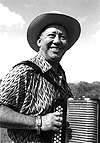Antonio "Tony" De La Rosa
Tejano Conjunto Accordionist, Riviera, Texas The Texas-Mexican conjunto, literally "ensemble," was born through the introduction of the Central European button
accordion in the decades around the turn of the twentieth century into a longstanding Mexican working class community in
southern Texas. Mexican music of the region had been shaped by the nineteenth-century Mexican tradition of European-
derived dance music -- polka, schottische, mazurka, waltz, and the like -- performed mainly by stringed instruments.
Along with the arrival of German, Czech, and Polish immigrants to southern Texas and Northern Mexico in the late 1800s
came the button accordion. By the 1930s, pioneer conjunto performers such as Narciso Martínez and Santiago
Jiménez had made the accordion sound a standard part of Mexican-American life in Texas and beyond through their
work with the emerging record and radio industries. The nueva generación "new generation" that came along after
World War II forged a conjunto sound better suited for larger dance halls, amplified music, and modern recordings, while
remaining loyal to the tastes of the tradition's working-class base. No conjunto musician of new generation era was more
prolific and influential than Antonio "Tony" de la Rosa.
The Texas-Mexican conjunto, literally "ensemble," was born through the introduction of the Central European button
accordion in the decades around the turn of the twentieth century into a longstanding Mexican working class community in
southern Texas. Mexican music of the region had been shaped by the nineteenth-century Mexican tradition of European-
derived dance music -- polka, schottische, mazurka, waltz, and the like -- performed mainly by stringed instruments.
Along with the arrival of German, Czech, and Polish immigrants to southern Texas and Northern Mexico in the late 1800s
came the button accordion. By the 1930s, pioneer conjunto performers such as Narciso Martínez and Santiago
Jiménez had made the accordion sound a standard part of Mexican-American life in Texas and beyond through their
work with the emerging record and radio industries. The nueva generación "new generation" that came along after
World War II forged a conjunto sound better suited for larger dance halls, amplified music, and modern recordings, while
remaining loyal to the tastes of the tradition's working-class base. No conjunto musician of new generation era was more
prolific and influential than Antonio "Tony" de la Rosa.
Born in 1931 in Sarita, Texas, a worker's hamlet on the King Ranch, he was one of twelve children in a family of field laborers. "All of us, my brothers and I, went out with my father. Tell me about cucumbers, hoeing, tomatoes, onions--we did it all," he remembers. At the age of six, his mother taught him to play harmonica. "Then I heard the accordion on the radio. We were living on an hacienda where my parents worked and I heard the accordion come from a radio in the kitchen. I got hold of one and learned to pick out the chords." He imitated the recordings of accordion pioneer Narciso Martínez, and at the age of sixteen, he went to nearby Kingsville and played in the small taverns there: "I spent a lot of time with my accordion on one side of me and the shoeshine box on the other." In 1949, he made his first recording, two polkas, Sarita and Tres Ríos, and the next year joined the Ideal label, through which, according to conjunto scholar Dr. Manuel Peña, "He began to turn out all the polkas that were to make his name a household word among the tejano [Texas-Mexican] working class ... Beyond any doubt, by the mid-1950s de la Rosa's conjunto was the most popular accordion group in Texas." Also by this time, de la Rosa had codified the instrumentation of the conjunto tejano that endures to this day--button accordion, amplified bajo sexto [a Mexican 12-string guitar], electric bass, and drum set. In adding the drum set and replacing the upright acoustic bass with the electric bass, he also changed the musical style: the polka tempo slowed, ushering in the new tachuachito dance style that evoked the slow, gliding movements of the possum (tacuache); the accordion and bajo sexto were freed to develop more individualistic stylistic nuances; and a more deliberate, staccato character marked his accordion melodies. His much- imitated 1956 instrumental rendition of the song Atotonilco hastened the acceptance of his changes.
In addition to constantly touring throughout the United States to wherever large numbers of farm workers were to be found, Tony de la Rosa and his Conjunto de la Rosa (that has included two of his brothers) made over 75 long-play recordings and many other singles. He was inducted into the Conjunto Music Hall of Fame in San Antonio in 1982. Peña sums up de la Rosa's place in music history: "To this day Tony de la Rosa stands out as a larger-than-life icon of a style whose cultural power few regional musicians in the Americas can match."